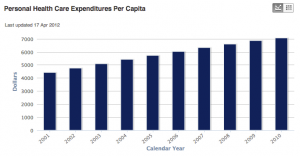Federal Open Data Dashboard Graphs Health Care System
The United States Department of Health and Human Services operates the Health System Measurement Project, which is an open data dashboard featuring more than 50 U.S. health system indicators in interactive graphs and charts. According to HHS, the website presents “national trend data as well as detailed views broken out by population characteristics such as age, sex, income level, and insurance coverage status.”
These indicators include extremely specific data, such graphs of the Percentage of Office-Based Physicians who have Electronic Medical Records, Out-of-Pocket Medicare Prescription Expenses, and Personal Health Expenditures Per Capita. The data is made available to explore in interactive charts and graphs, but is also made available in downloadable CSV files, compatible with any spreadsheet program.
In May, HHS announced the dashboard in a press release:
Health and Human Services (HHS) Secretary Kathleen Sebelius today announced the launch of a new web-based tool that will make it easier for all Americans to monitor and measure how the nation’s health care system is performing.
The web-based tool, known as the Health System Measurement Project, will allow policymakers, providers, and the public to develop consistent data-driven views of changes in critical U.S. health system indicators.
”I am pleased that this tool will allow people to have better access to data about our health care system,” Secretary Sebelius said. “Ensuring all Americans have access to these data is an important way to make our health care system more open and transparent.”
The Health System Measurement Project brings together datasets from across the federal government that span topical areas, such as access to care, cost and affordability, prevention and health information technology. It presents these indicators by population characteristics, such as age, sex, income level, insurance coverage, and geography.
Using the Measurement Project, one can quickly view data on a given topical area from multiple sources, compare trends across measures and compare national trends with those at the state and regional level. For example, an individual could use the Measurement Project to monitor the percentage of people who have a specific source of ongoing medical care or track avoidable hospitalizations for adults and children by region or ethnic group.
The measures included in the Health System Measurement Project, developed and selected by the HHS Office of the Assistant Secretary for Planning and Evaluation, are aligned with the HHS Strategic Plan, the National Quality Strategy, and other departmental strategic planning efforts. The measures are drawn primarily from existing publicly available datasets. The tool contains information on how the measures were calculated and provides users with direct links back to the original data sources.
To access the Health System Measurement Project, go to HealthMeasures.aspe.hhs.gov.

